weight LEXUS RX400H 2008 Owners Manual
[x] Cancel search | Manufacturer: LEXUS, Model Year: 2008, Model line: RX400H, Model: LEXUS RX400H 2008Pages: 487, PDF Size: 6.96 MB
Page 65 of 487
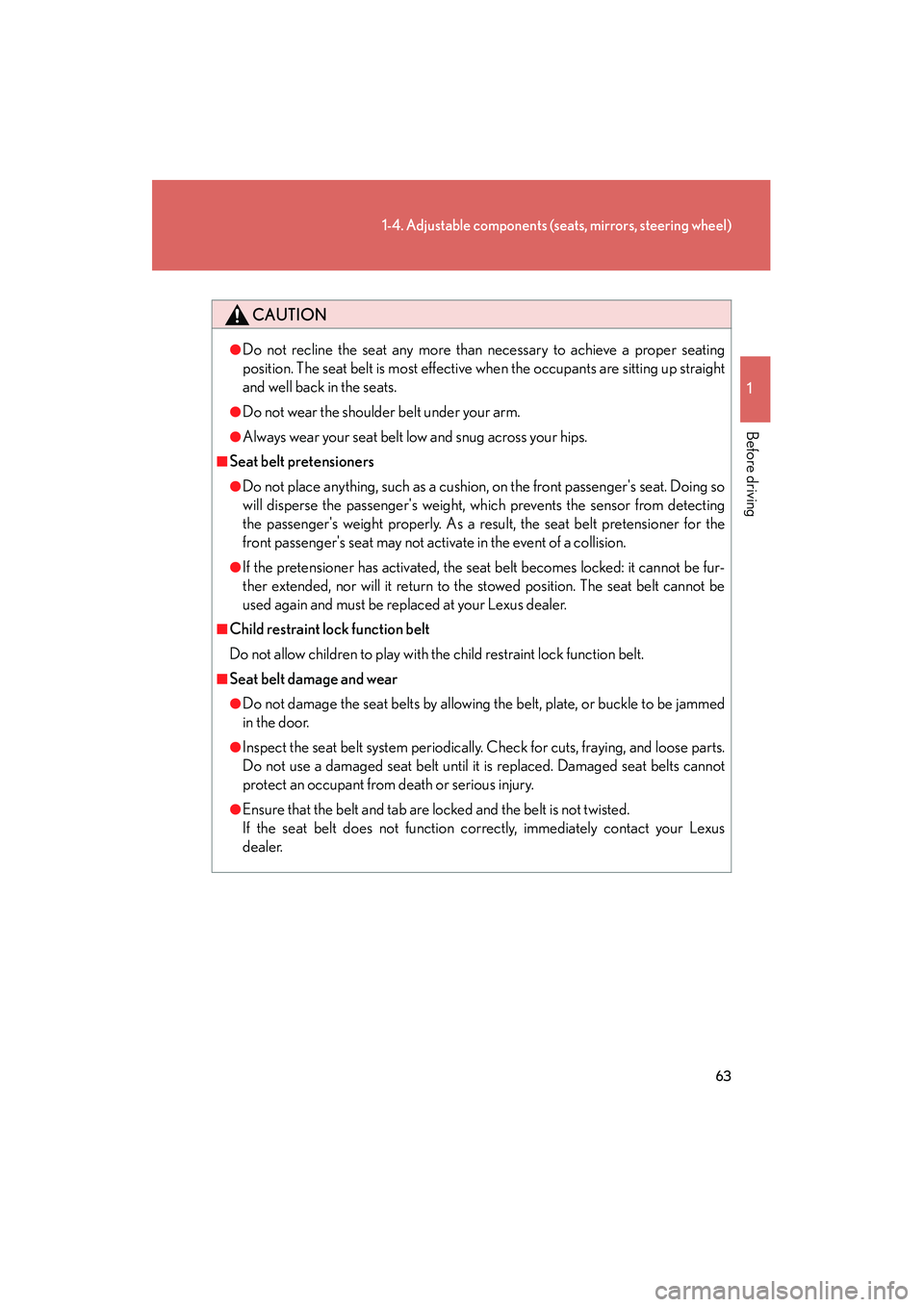
63
1-4. Adjustable components (seats, mirrors, steering wheel)
1
Before driving
RX400h_U
CAUTION
●Do not recline the seat any more than necessary to achieve a proper seating
position. The seat belt is most effective when the occupants are sitting up straight
and well back in the seats.
●Do not wear the shoulder belt under your arm.
●Always wear your seat belt low and snug across your hips.
■Seat belt pretensioners
●Do not place anything, such as a cushion, on the front passenger's seat. Doing so
will disperse the passenger's weight, which prevents the sensor from detecting
the passenger's weight properly. As a result, the seat belt pretensioner for the
front passenger's seat may not activate in the event of a collision.
●If the pretensioner has activated, the seat belt becomes locked: it cannot be fur-
ther extended, nor will it return to the stowed position. The seat belt cannot be
used again and must be replaced at your Lexus dealer.
■Child restraint lock function belt
Do not allow children to play with the child restraint lock function belt.
■Seat belt damage and wear
●Do not damage the seat belts by allowing the belt, plate, or buckle to be jammed
in the door.
●Inspect the seat belt system periodically. Check for cuts, fraying, and loose parts.
Do not use a damaged seat belt until it is replaced. Damaged seat belts cannot
protect an occupant from death or serious injury.
●Ensure that the belt and tab are locked and the belt is not twisted.
If the seat belt does not function correctly, immediately contact your Lexus
dealer.
Page 73 of 487
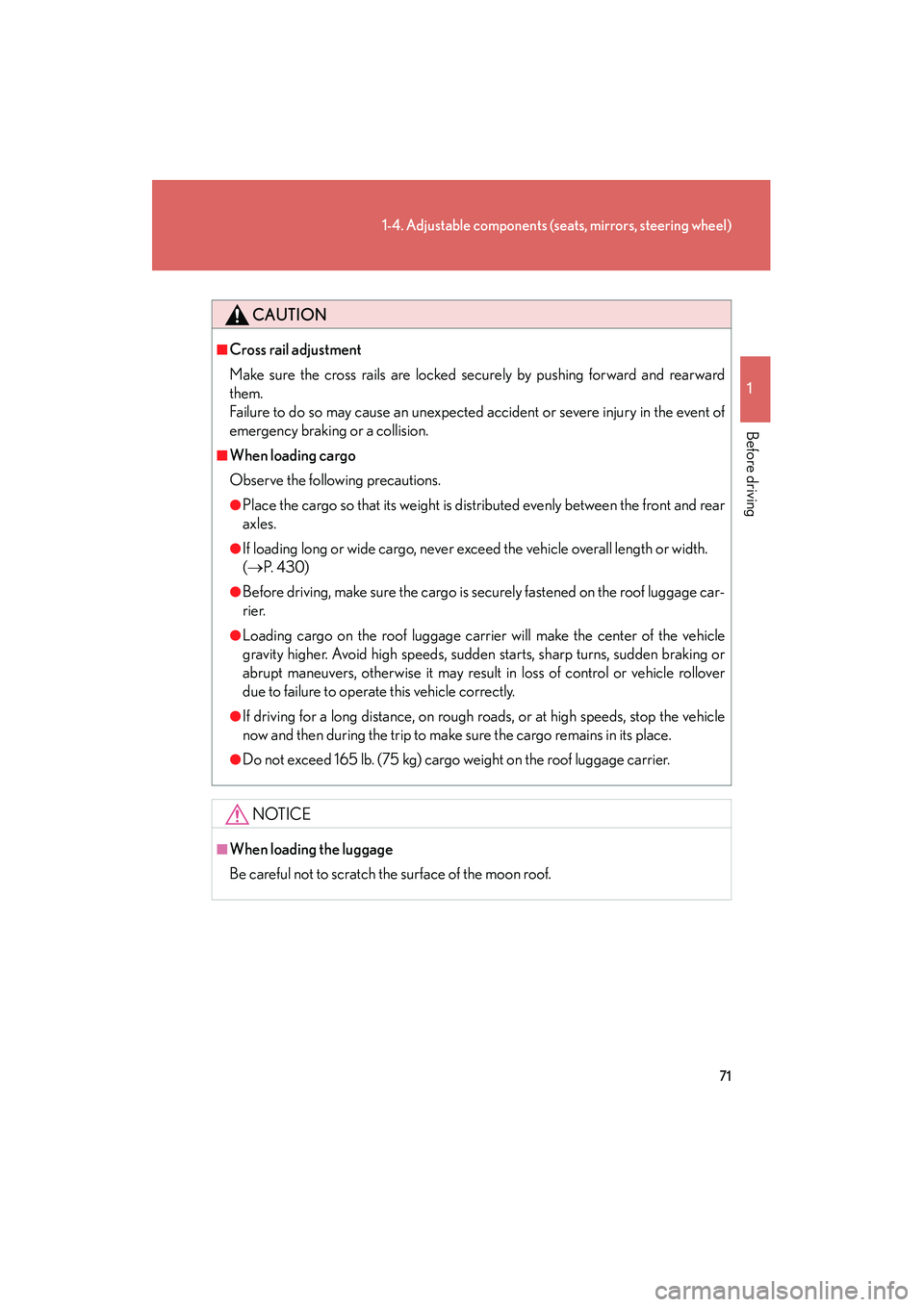
71
1-4. Adjustable components (seats, mirrors, steering wheel)
1
Before driving
RX400h_U
CAUTION
■Cross rail adjustment
Make sure the cross rails are locked securely by pushing forward and rearward
them.
Failure to do so may cause an unexpected accident or severe injury in the event of
emergency braking or a collision.
■When loading cargo
Observe the following precautions.
●Place the cargo so that its weight is distributed evenly between the front and rear
axles.
●If loading long or wide cargo, never exceed the vehicle overall length or width.
(→ P. 4 3 0 )
●Before driving, make sure the cargo is securely fastened on the roof luggage car-
rier.
●Loading cargo on the roof luggage carrier will make the center of the vehicle
gravity higher. Avoid high speeds, sudden starts, sharp turns, sudden braking or
abrupt maneuvers, otherwise it may result in loss of control or vehicle rollover
due to failure to operate this vehicle correctly.
●If driving for a long distance, on rough roads, or at high speeds, stop the vehicle
now and then during the trip to make sure the cargo remains in its place.
●Do not exceed 165 lb. (75 kg) cargo weight on the roof luggage carrier.
NOTICE
■When loading the luggage
Be careful not to scratch the surface of the moon roof.
Page 104 of 487
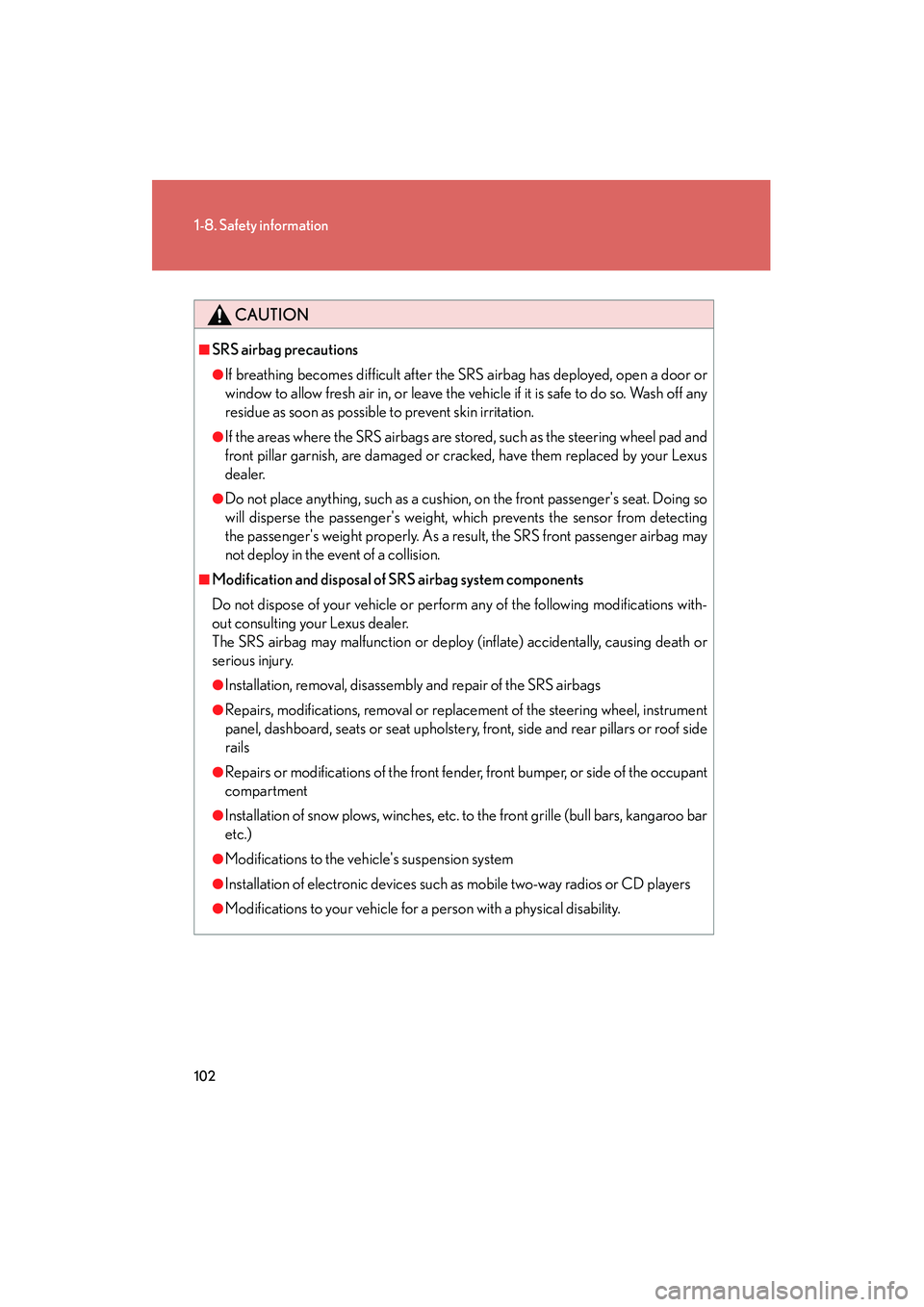
102
1-8. Safety information
RX400h_U
CAUTION
■SRS airbag precautions
●If breathing becomes difficult after the SRS airbag has deployed, open a door or
window to allow fresh air in, or leave the vehicle if it is safe to do so. Wash off any
residue as soon as possible to prevent skin irritation.
●If the areas where the SRS airbags are stored, such as the steering wheel pad and
front pillar garnish, are damaged or cracked, have them replaced by your Lexus
dealer.
●Do not place anything, such as a cushion, on the front passenger's seat. Doing so
will disperse the passenger's weight, which prevents the sensor from detecting
the passenger's weight properly. As a result, the SRS front passenger airbag may
not deploy in the event of a collision.
■Modification and disposal of SRS airbag system components
Do not dispose of your vehicle or perform any of the following modifications with-
out consulting your Lexus dealer.
The SRS airbag may malfunction or deploy (inflate) accidentally, causing death or
serious injury.
●Installation, removal, disassembly and repair of the SRS airbags
●Repairs, modifications, removal or replacement of the steering wheel, instrument
panel, dashboard, seats or seat upholstery, front, side and rear pillars or roof side
rails
●Repairs or modifications of the front fender, front bumper, or side of the occupant
compartment
●Installation of snow plows, winches, etc. to the front grille (bull bars, kangaroo bar
etc.)
●Modifications to the vehicle's suspension system
●Installation of electronic devices such as mobile two-way radios or CD players
●Modifications to your vehicle for a person with a physical disability.
Page 108 of 487
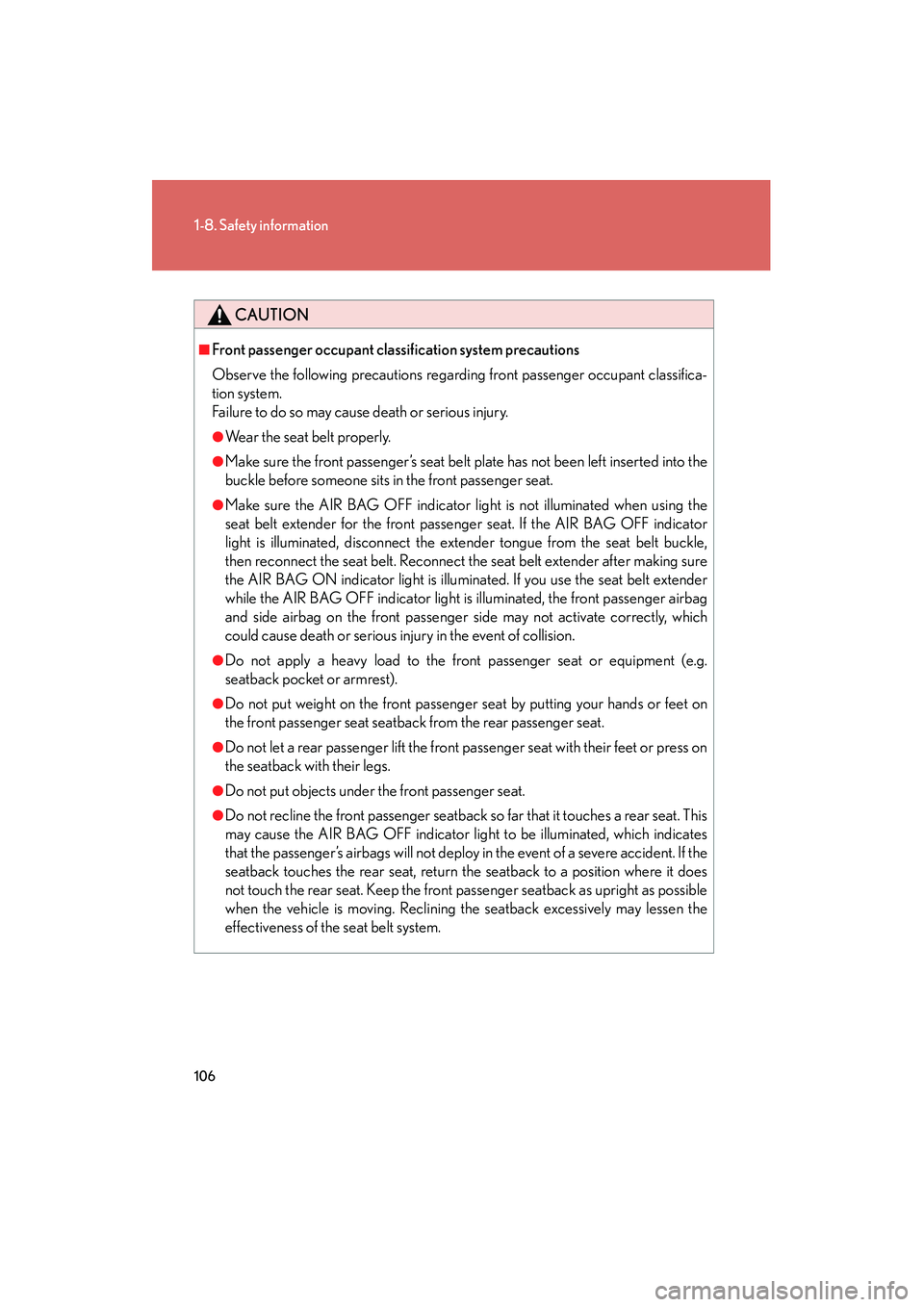
106
1-8. Safety information
RX400h_U
CAUTION
■Front passenger occupant classification system precautions
Observe the following precautions regarding front passenger occupant classifica-
tion system.
Failure to do so may cause death or serious injury.
●Wear the seat belt properly.
●Make sure the front passenger’s seat belt plate has not been left inserted into the
buckle before someone sits in the front passenger seat.
●Make sure the AIR BAG OFF indicator light is not illuminated when using the
seat belt extender for the front passenger seat. If the AIR BAG OFF indicator
light is illuminated, disconnect the extender tongue from the seat belt buckle,
then reconnect the seat belt. Reconnect the seat belt extender after making sure
the AIR BAG ON indicator light is illuminated. If you use the seat belt extender
while the AIR BAG OFF indicator light is illuminated, the front passenger airbag
and side airbag on the front passenger side may not activate correctly, which
could cause death or serious injury in the event of collision.
●Do not apply a heavy load to the front passenger seat or equipment (e.g.
seatback pocket or armrest).
●Do not put weight on the front passenger seat by putting your hands or feet on
the front passenger seat seatback from the rear passenger seat.
●Do not let a rear passenger lift the front passenger seat with their feet or press on
the seatback with their legs.
●Do not put objects under the front passenger seat.
●Do not recline the front passenger seatback so far that it touches a rear seat. This
may cause the AIR BAG OFF indicator light to be illuminated, which indicates
that the passenger’s airbags will not deploy in the event of a severe accident. If the
seatback touches the rear seat, return the seatback to a position where it does
not touch the rear seat. Keep the front passenger seatback as upright as possible
when the vehicle is moving. Reclining the seatback excessively may lessen the
effectiveness of the seat belt system.
Page 180 of 487
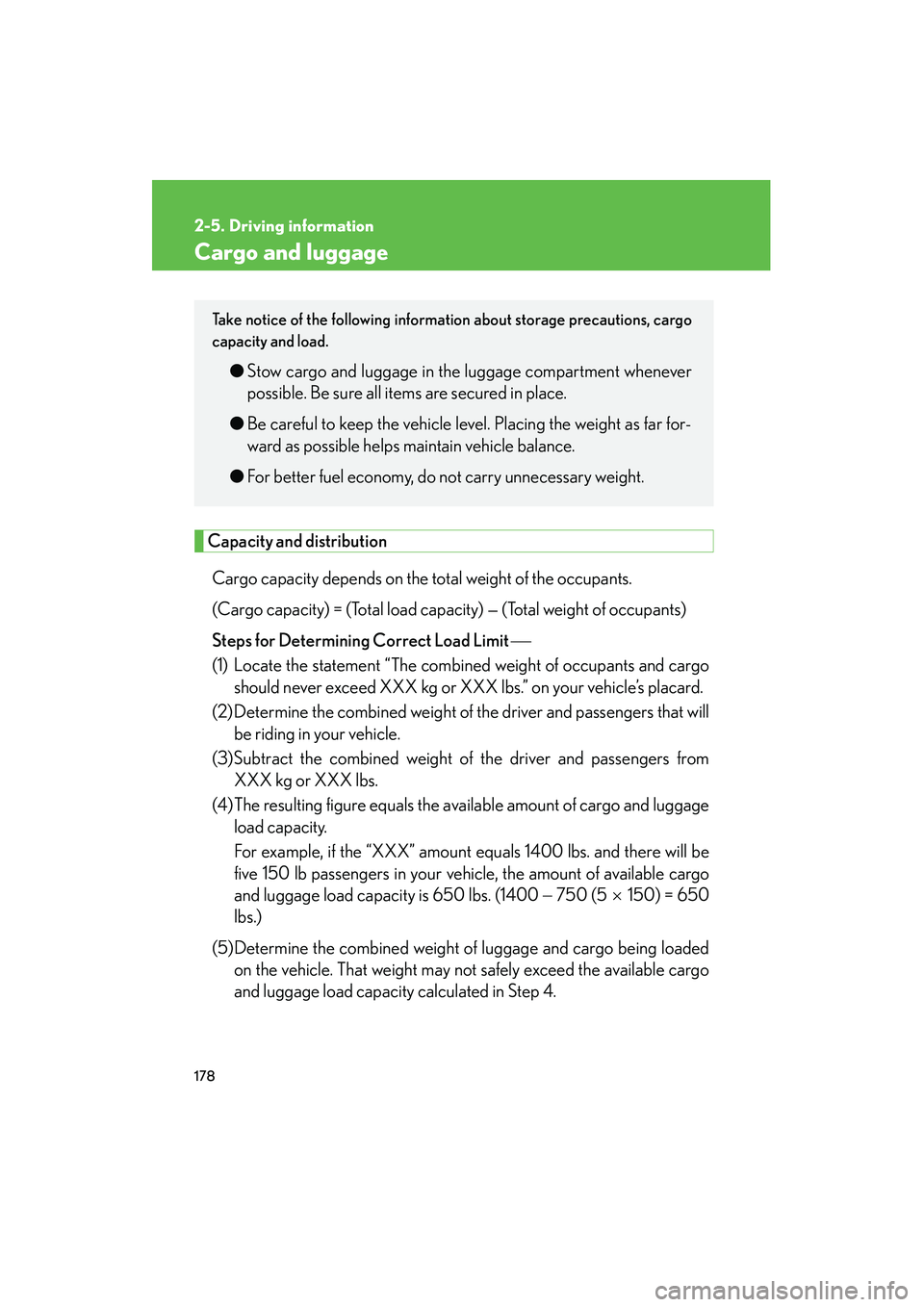
178
2-5. Driving information
RX400h_U
Cargo and luggage
Capacity and distributionCargo capacity depends on the total weight of the occupants.
(Cargo capacity) = (Total load cap acity) — (Total weight of occupants)
Steps for Determining Correct Load Limit
(1) Locate the statement “The combined weight of occupants and cargo should never exceed XXX kg or XXX lbs.” on your vehicle’s placard.
(2) Determine the combined weight of the driver and passengers that will be riding in your vehicle.
(3)Subtract the combined weight of the driver and passengers from XXX kg or XXX lbs.
(4) The resulting figure equals the available amount of cargo and luggage load capacity.
For example, if the “XXX” amount equals 1400 lbs. and there will be
five 150 lb passengers in your vehicle, the amount of available cargo
and luggage load capacity is 650 lbs. (1400 − 750 (5 × 150) = 650
lbs.)
(5)Determine the combined weight of luggage and cargo being loaded on the vehicle. That weight may not safely exceed the available cargo
and luggage load capacity calculated in Step 4.
Take notice of the following information about storage precautions, cargo
capacity and load.
●Stow cargo and luggage in the luggage compartment whenever
possible. Be sure all items are secured in place.
● Be careful to keep the vehicle level. Placing the weight as far for-
ward as possible helps maintain vehicle balance.
● For better fuel economy, do not carry unnecessary weight.
Page 181 of 487
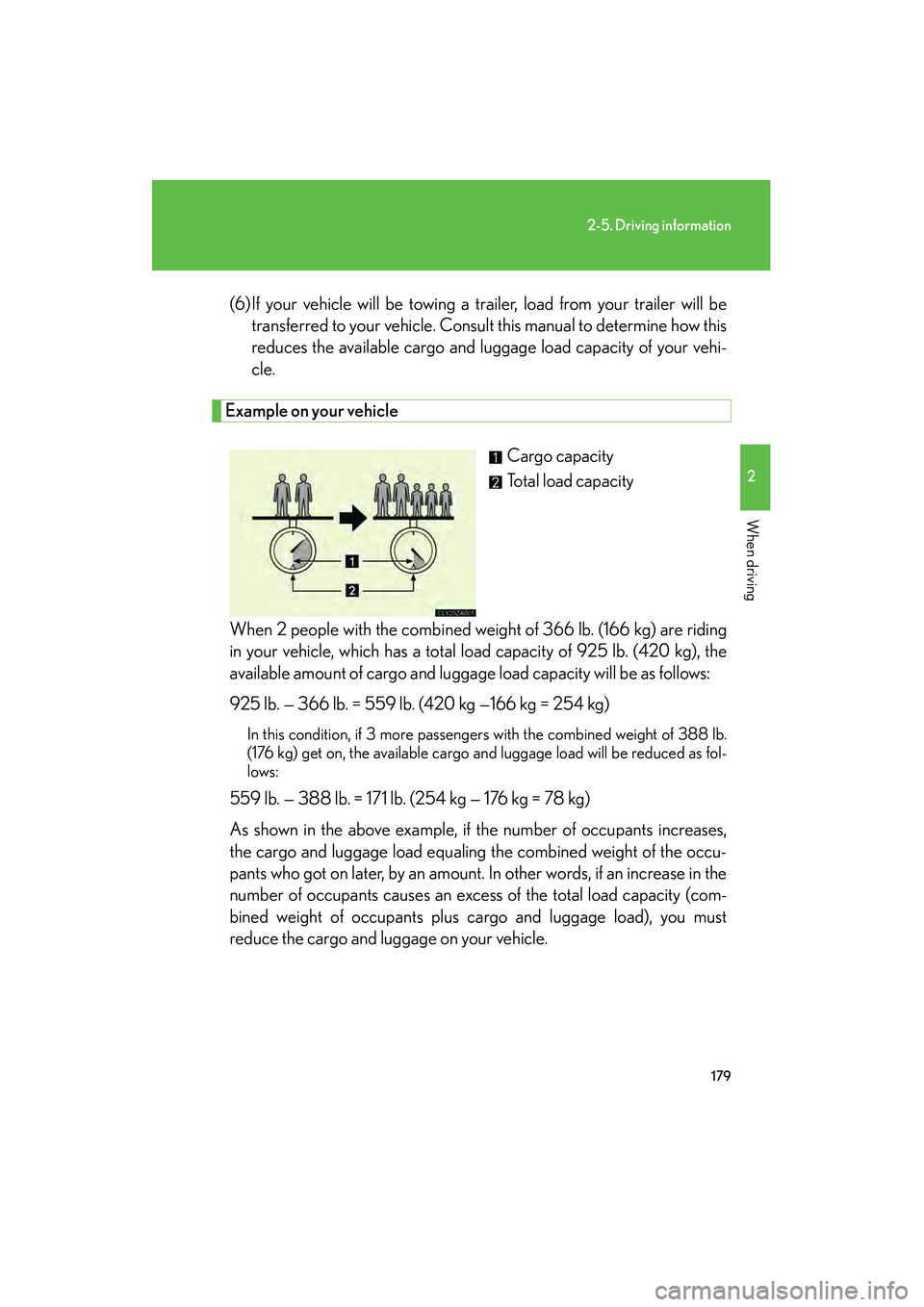
179
2-5. Driving information
2
When driving
RX400h_U(6) If your vehicle will be towing a trailer, load from your trailer will be
transferred to your vehicle. Consult this manual to determine how this
reduces the available cargo and luggage load capacity of your vehi-
cle.
Example on your vehicle
Cargo capacity
Total load capacity
When 2 people with the combined weight of 366 lb. (166 kg) are riding
in your vehicle, which has a total load capacity of 925 lb. (420 kg), the
available amount of cargo and luggage load capacity will be as follows:
925 lb. — 366 lb. = 559 lb. (420 kg —166 kg = 254 kg)
In this condition, if 3 more passengers with the combined weight of 388 lb.
(176 kg) get on, the available cargo and luggage load will be reduced as fol-
lows:
559 lb. — 388 lb. = 171 lb. (254 kg — 176 kg = 78 kg)
As shown in the above example, if the number of occupants increases,
the cargo and luggage load equaling the combined weight of the occu-
pants who got on later, by an amount. In other words, if an increase in the
number of occupants causes an excess of the total load capacity (com-
bined weight of occupants plus cargo and luggage load), you must
reduce the cargo and luggage on your vehicle.
Page 182 of 487
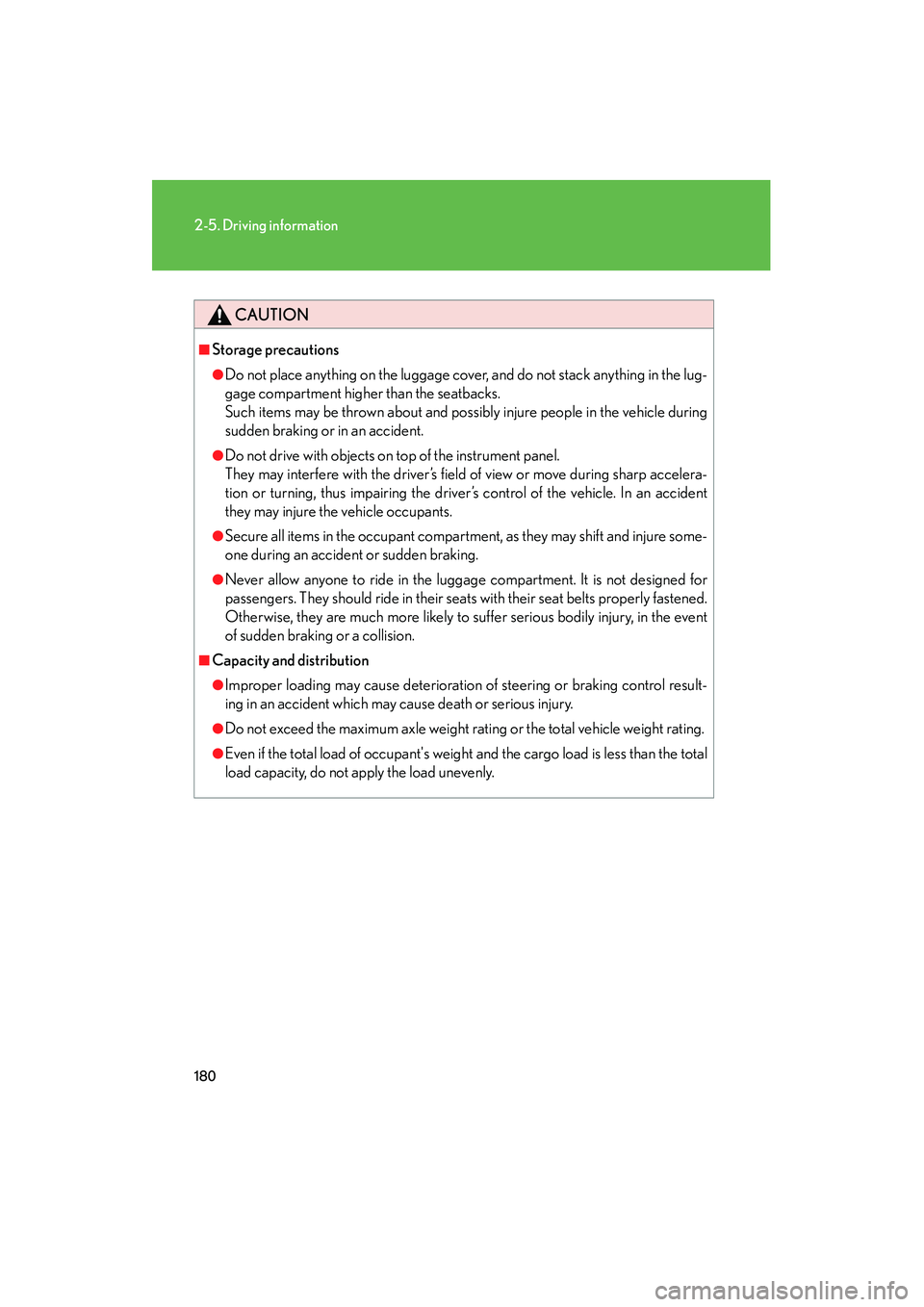
180
2-5. Driving information
RX400h_U
CAUTION
■Storage precautions
●Do not place anything on the luggage cover, and do not stack anything in the lug-
gage compartment higher than the seatbacks.
Such items may be thrown about and possibly injure people in the vehicle during
sudden braking or in an accident.
●Do not drive with objects on top of the instrument panel.
They may interfere with the driver’s field of view or move during sharp accelera-
tion or turning, thus impairing the driver’s control of the vehicle. In an accident
they may injure the vehicle occupants.
●Secure all items in the occupant compartment, as they may shift and injure some-
one during an accident or sudden braking.
●Never allow anyone to ride in the luggage compartment. It is not designed for
passengers. They should ride in their seats with their seat belts properly fastened.
Otherwise, they are much more likely to suffer serious bodily injury, in the event
of sudden braking or a collision.
■Capacity and distribution
●Improper loading may cause deterioration of steering or braking control result-
ing in an accident which may cause death or serious injury.
●Do not exceed the maximum axle weight rating or the total vehicle weight rating.
●Even if the total load of occupant's weight and the cargo load is less than the total
load capacity, do not apply the load unevenly.
Page 183 of 487
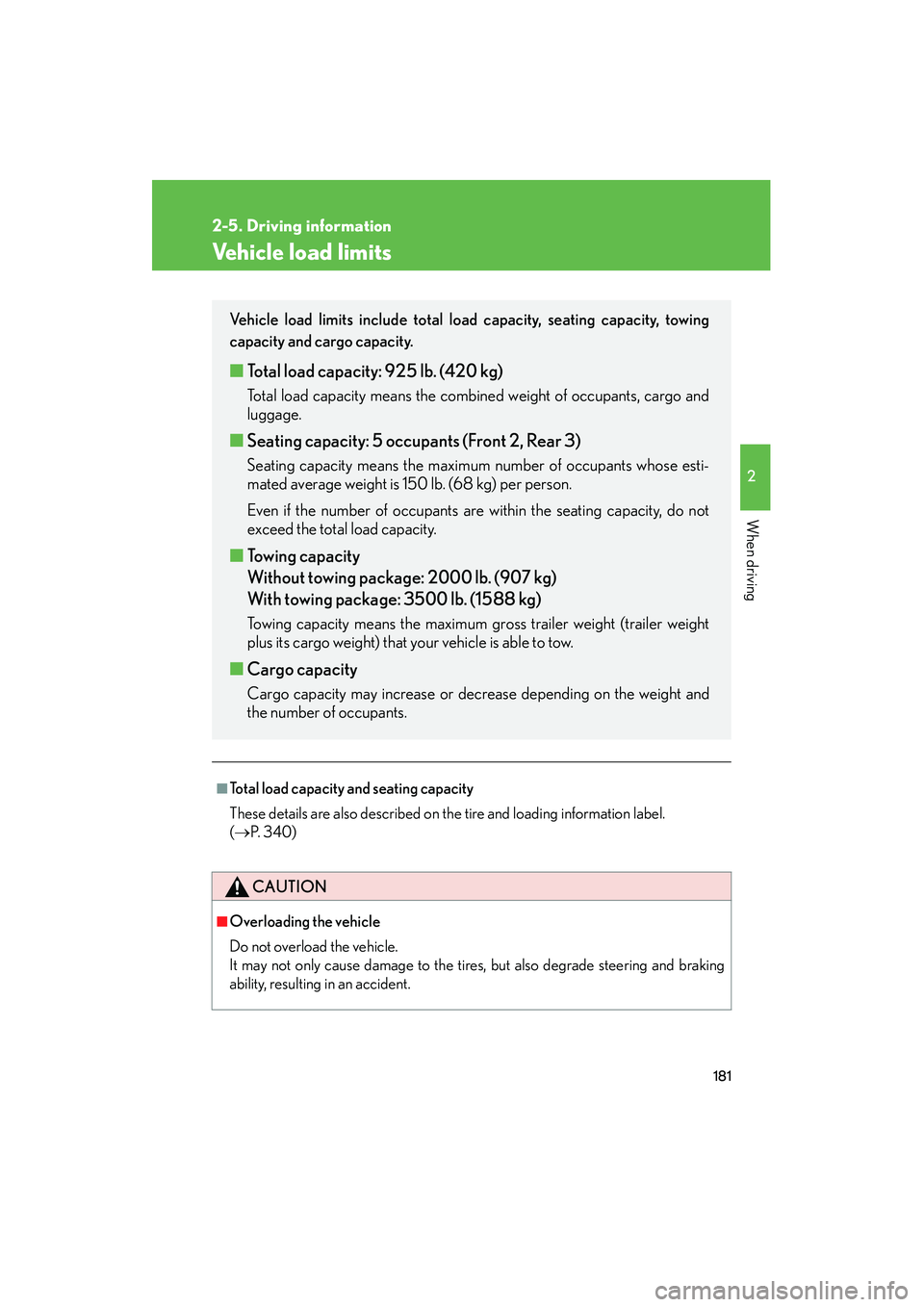
181
2-5. Driving information
2
When driving
RX400h_U
Vehicle load limits
■Total load capacity and seating capacity
These details are also described on the tire and loading information label.
(→ P. 3 4 0 )
CAUTION
■Overloading the vehicle
Do not overload the vehicle.
It may not only cause damage to the tires, but also degrade steering and braking
ability, resulting in an accident.
Vehicle load limits include total load capacity, seating capacity, towing
capacity and cargo capacity.
■Total load capacity: 925 lb. (420 kg)
Total load capacity means the combined weight of occupants, cargo and
luggage.
■Seating capacity: 5 occupants (Front 2, Rear 3)
Seating capacity means the maximum number of occupants whose esti-
mated average weight is 150 lb. (68 kg) per person.
Even if the number of occupants are within the seating capacity, do not
exceed the total load capacity.
■Towing capacity
Without towing package: 2000 lb. (907 kg)
With towing package: 3500 lb. (1588 kg)
Towing capacity means the maximum gross trailer weight (trailer weight
plus its cargo weight) that your vehicle is able to tow.
■Cargo capacity
Cargo capacity may increase or decrease depending on the weight and
the number of occupants.
Page 189 of 487
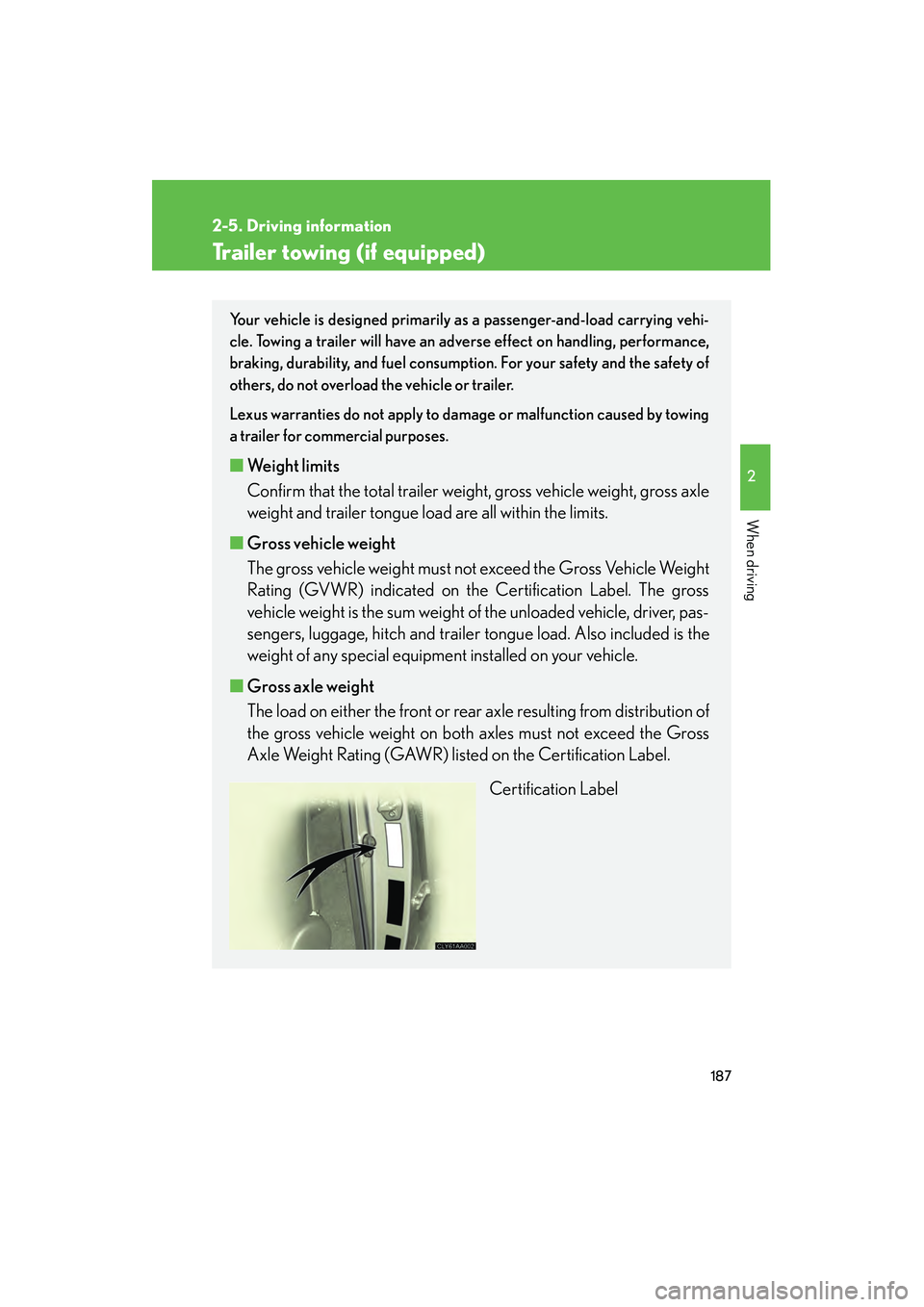
187
2-5. Driving information
2
When driving
RX400h_U
Trailer towing (if equipped)
Your vehicle is designed primarily as a passenger-and-load carrying vehi-
cle. Towing a trailer will have an adverse effect on handling, performance,
braking, durability, and fuel consumption. For your safety and the safety of
others, do not overload the vehicle or trailer.
Lexus warranties do not apply to damage or malfunction caused by towing
a trailer for commercial purposes.
■ Weight limits
Confirm that the total trailer weight, gross vehicle weight, gross axle
weight and trailer tongue load are all within the limits.
■ Gross vehicle weight
The gross vehicle weight must not exceed the Gross Vehicle Weight
Rating (GVWR) indicated on the Certification Label. The gross
vehicle weight is the sum weight of the unloaded vehicle, driver, pas-
sengers, luggage, hitch and trailer tongue load. Also included is the
weight of any special equipment installed on your vehicle.
■ Gross axle weight
The load on either the front or rear axle resulting from distribution of
the gross vehicle weight on both axles must not exceed the Gross
Axle Weight Rating (GAWR) listed on the Certification Label.
Certification Label
Page 190 of 487
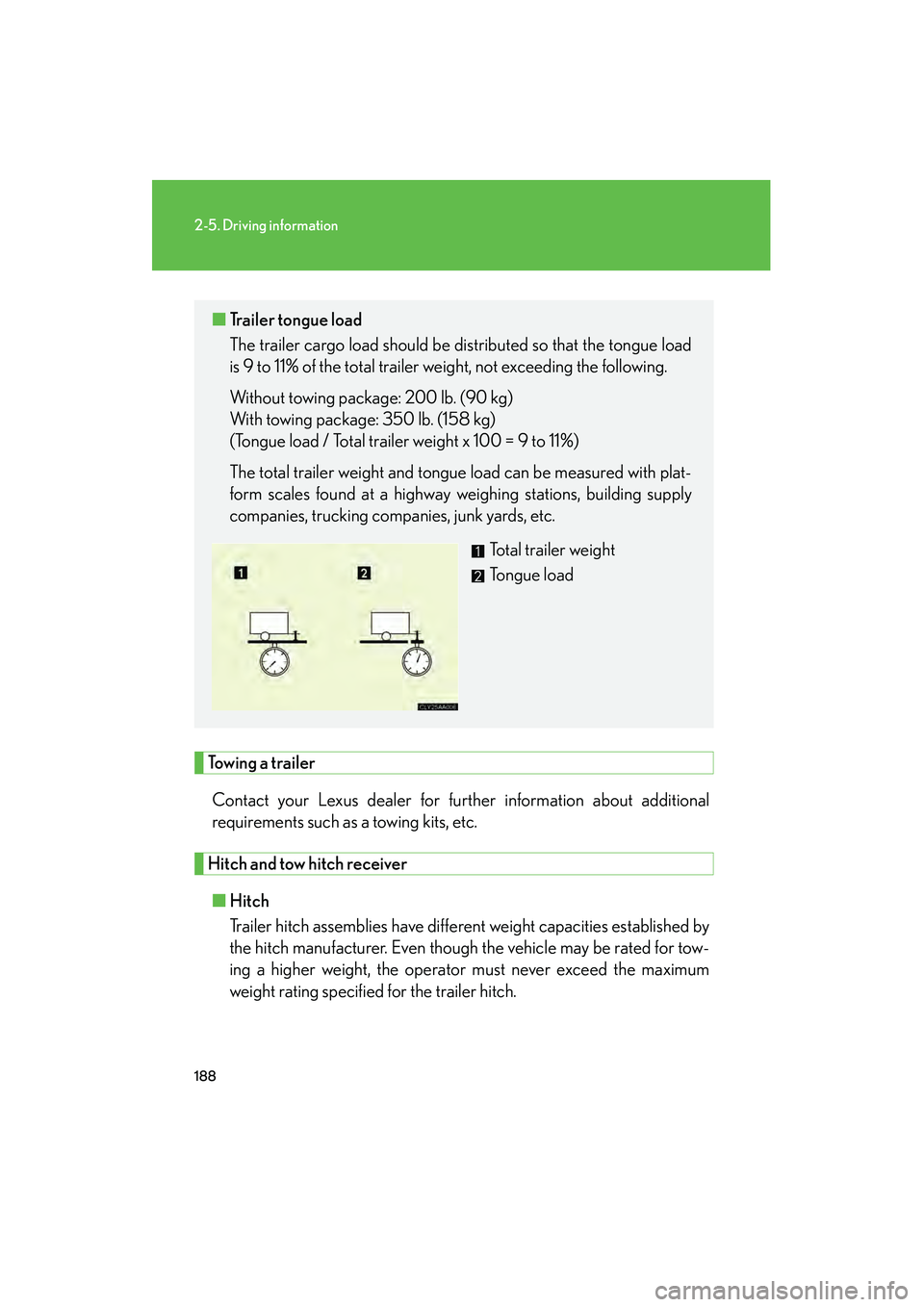
188
2-5. Driving information
RX400h_U
Towing a trailerContact your Lexus dealer for further information about additional
requirements such as a towing kits, etc.
Hitch and tow hitch receiver■ Hitch
Trailer hitch assemblies have different weight capacities established by
the hitch manufacturer. Even though the vehicle may be rated for tow-
ing a higher weight, the operator must never exceed the maximum
weight rating specified for the trailer hitch.
■Trailer tongue load
The trailer cargo load should be distributed so that the tongue load
is 9 to 11% of the total trailer weight, not exceeding the following.
Without towing package: 200 lb. (90 kg)
With towing package: 350 lb. (158 kg)
(Tongue load / Total trailer weight x 100 = 9 to 11%)
The total trailer weight and tongue load can be measured with plat-
form scales found at a highway weighing stations, building supply
companies, trucking companies, junk yards, etc.
Total trailer weight
Tongue load